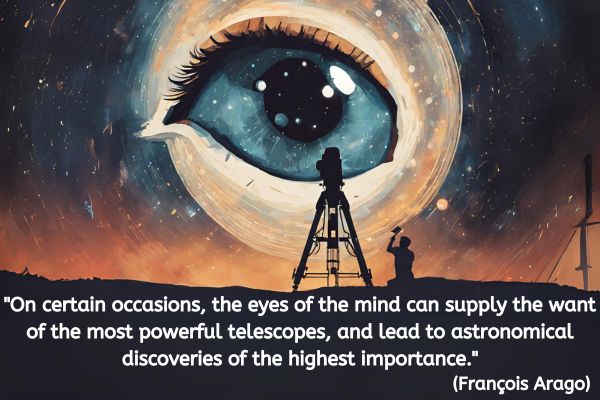
Today’s quote is:
“On certain occasions, the eyes of the mind can supply the want of the most powerful telescopes, and lead to astronomical discoveries of the highest importance.” (François Arago)
This powerful statement serves as a testament to the incredible capacity of our minds to envision possibilities beyond the constraints of external resources. As coaches, we are the navigators guiding our clients to tap into the innate creativity and insight within them, unlocking breakthroughs that might seem beyond reach.
The Magic Within:
In both personal and professional spheres, I suspect as coaches we often find ourselves helping clients harness the power of their “mind’s eye” or their internal creativity. It’s akin to unlocking a magical realm where limitations fade away, and possibilities become boundless. This process of tapping into one’s inner resources can lead to revelations and breakthroughs that might have seemed improbable or unattainable.
My guess is that depending upon your approach to coaching that the way that you introduce this and the way you guide your client could be very different.
Inspiring the Utilisation of the “Eyes of the Mind”:
The question arises: How do we, as coaches, inspire those around us to utilize their “eyes of the mind”? What strategies, techniques, or approaches do we employ to unlock the creative potential within our clients? Here are some perspectives that different coaches and methodolgies may employ:
Visualization Techniques:
Encourage clients to engage in visualization exercises. By vividly picturing their goals, challenges, or desired outcomes, they can activate their creative faculties and gain new insights.
Mindfulness Practices:
Introduce mindfulness practices to help clients quiet the noise of external distractions. In these moments of stillness, the mind can often reveal profound insights and creative solutions.
Open-Ended Questions:
Pose open-ended questions that stimulate deep thinking and imaginative exploration. These questions can act as catalysts, prompting clients to look beyond the surface and into the realms of possibility.
Creative Assignments:
Assign creative tasks or homework that encourage clients to express themselves through various mediums—writing, drawing, or even role-playing. These activities can tap into uncharted territories of the mind.
Metaphors and Analogies:
Use metaphors and analogies to illustrate concepts. Metaphors have a unique ability to transcend literal understanding, allowing clients to connect with ideas on a deeper, more intuitive level.
Sharing Your Insights:
I take a pragmatic approach of – does it work? If you’re making a positive difference with the work that you do with your clients then that should be applauded. I personally also take the approach that coaching is an art and a science and that I’m always on the look out to ensure that I’m producing the best piece of art that I can based upon the science of my understanding at that time.
Most of the time I work with clients in a longer term rather than a one off session specifically looking at one isolated situation. Which means at this moment in time I’m very likley to spend time on the “big picture” of what is that creativity/ inner wisdom etc so that a client can access that in the future for other instances rather than it seeming to be some magic trick I pulled off that allowed them to be creative in one specific situation.
How do you inspire the utilisation of the “eyes of the mind” in your coaching practice? What approach have proven effective for you? I invite you to share your thoughts and perspectives below.
About Jen Waller

Jen Waller is on a mission to support, nurture and encourage coaching skills and talents from non-coach to coach and beyond.
As an experienced coach and trainer Jen is happy to utilise all skills at her disposal to assist clients from getting out of their own way and making a difference in the world with their coaching. Find out more about the support Jen offers here.